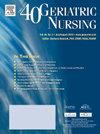A predictive model for depression in elderly people with arthritis based on the TRIPOD guidelines
IF 2.5
3区 医学
Q3 GERIATRICS & GERONTOLOGY
引用次数: 0
Abstract
Objective
Through machine learning algorithms, a prediction model for depression in arthritis patients was established to provide a basis for related interventions.
Methods
Data from 4240 patients with arthritis were collected from the National Health and Nutrition Examination Survey database and divided into a training set (70 %) and a test set (30 %). LASSO Regression was employed for feature variable selection, and predictive models were constructed using five machine learning algorithms: Random Forest (RF), Logistic Regression (LR), Extreme Gradient Boosting (XGBoost), Gaussian Naive Bayes (GNB), and Gradient Boosting Decision Tree (GBDT). Model performance was evaluated through various metrics, including the Area Under the Receiver Operating Characteristic Curve (AUC), accuracy, sensitivity, cutoff, recall, Kappa, Positive Predictive Value(PPV) and Negative Predictive Value(NPV). Additionally, Shapley Additive Explanations (SHAP) analysis was conducted for personalized risk assessment.
Result
The predictive performance of the random forest model was the highest,with an area under curve (AUC) of 0.811 (SD:0.000) for the training set and 0.780 (SD:0.001) for the test set. The model identified eight significant variables associated with the occurrence of arthritis depression, including health status, difficulty standing for extended periods, difficulty getting in and out of bed, difficulty sitting for prolonged durations, education, gender, difficulty managing finances, and race. DCA demonstrated that the nomogram was clinically beneficial.
Conclusion
The predictive model developed for identifying depression in patients with arthritis exhibits high predictive ability, and good clinical applicability. This model can aid healthcare providers in the early detection of depression, thereby enabling timely interventions that can enhance patient prognosis and promote healthy aging. Future research should incorporate real-time biomarker monitoring to refine dynamic risk assessment.
基于 TRIPOD 指南的老年关节炎患者抑郁预测模型
目的通过机器学习算法,建立关节炎患者抑郁的预测模型,为相关干预提供依据。方法从全国健康与营养检查调查数据库中收集4240例关节炎患者的数据,分为训练组(70%)和测试组(30%)。采用LASSO回归进行特征变量选择,并使用随机森林(RF)、逻辑回归(LR)、极端梯度增强(XGBoost)、高斯朴素贝叶斯(GNB)和梯度增强决策树(GBDT)五种机器学习算法构建预测模型。通过各种指标评估模型的性能,包括受试者工作特征曲线下面积(AUC)、准确性、灵敏度、截止值、召回率、Kappa、阳性预测值(PPV)和阴性预测值(NPV)。此外,采用Shapley加性解释(SHAP)分析进行个性化风险评估。结果随机森林模型的预测效果最好,训练集的曲线下面积(AUC)为0.811 (SD:0.000),测试集的AUC为0.780 (SD:0.001)。该模型确定了与关节炎抑郁症发生相关的八个重要变量,包括健康状况、长时间站立困难、上下床困难、长时间坐着困难、教育程度、性别、财务管理困难和种族。DCA显示nomographic在临床上是有益的。结论所建立的关节炎患者抑郁预测模型预测能力强,具有较好的临床适用性。该模型可以帮助医疗保健提供者早期发现抑郁症,从而能够及时干预,提高患者预后,促进健康老龄化。未来的研究应纳入实时生物标志物监测,以完善动态风险评估。
本文章由计算机程序翻译,如有差异,请以英文原文为准。
求助全文
约1分钟内获得全文
求助全文
来源期刊

Geriatric Nursing
医学-护理
CiteScore
3.80
自引率
7.40%
发文量
257
审稿时长
>12 weeks
期刊介绍:
Geriatric Nursing is a comprehensive source for clinical information and management advice relating to the care of older adults. The journal''s peer-reviewed articles report the latest developments in the management of acute and chronic disorders and provide practical advice on care of older adults across the long term continuum. Geriatric Nursing addresses current issues related to drugs, advance directives, staff development and management, legal issues, client and caregiver education, infection control, and other topics. The journal is written specifically for nurses and nurse practitioners who work with older adults in any care setting.
 求助内容:
求助内容: 应助结果提醒方式:
应助结果提醒方式:


